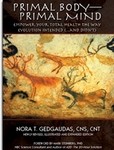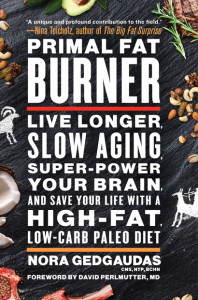Q: Hi Nora–I have a question for you regarding nutrition and exercise. I understand what you have written about nutrition and how it pertains to exercise. According to Dr. Sears, exercising in brief intense intervals is more beneficial than long, extended workouts. So, how do you explain an ultramarathoner who is in amazing shape with a resting heart rate of 38. Or a show like The Biggest Loser (a show of which the principle I respect but not so much the process)…the contestants eat according to the basic mainstream, food pyramid, “healthy” eating habits and they exercise intensely ALL day. They lose weight, get in shape, and get healthier (they reduce the medications they are on and resolve medical conditions). Many maintain their new lifestyles successfully. Please understand, I completely believe in the necessity and benefits of traditional nutrition, and understand what you say about carbohydrates and the havoc they wreak on our bodies. So, I am very interested to read your response to the ultramarathoner and The Biggest Loser contestants scenarios. Thank you. ~Angie
A: I hardly see marathon running and prolonged strenuous exercise as healthy pastimes. In fact, I see them as far more “health challenging” than health promoting. There is, in fact, what is treated in the press as a paradoxical phenomenon where cases of actual heart failure among distance runners (and other distance athletes) is becoming increasingly common. Remember, too, that Jim Fixx—the father of the modern running movement—also dropped dead from heart failure. Not all distance runners do damage to their hearts—but that doesn’t mean that marathon running should be considered the path to optimal heart health.
The following is borrowed from a publication called Peak Performance Newsletter (one of many, many sources commenting on this phenomenon):
The truth is that marathon runners, ironman triathletes and long-distance cyclists, swimmers, rowers and cross-country skiers are all in the same boat. In fact, any athlete who participates in a strenuous test of endurance lasting about three hours or more has an increased chance of dying during – and for 24 hours following – the exertion, even when the athlete’s chance of a death-door knock is compared with the risk incurred by a cigarette-smoking, sedentary layabout who spends the same 24 hours drinking beer and watching TV.
To find out why strenuous exercise temporarily increases the risk of death, researchers at the University of Innsbruck in Austria recently studied 38 male participants in the 1999 Tyrolean Otztaler Radmarathon, a cycling race which covers 230k, with an altitude change of 5,500m. The Radmarathon is often said to be comparable in difficulty to the hardest mountain stages of the Tour de France.
All 38 subjects were experienced, well-trained amateur cyclists who were free of cardiovascular risk factors and without evidence of heart disease. The Austrian researchers were especially interested in monitoring their blood levels of a specific heart enzyme called cardiac troponin I, which happens to be the most sensitive and specific marker for the detection of heart-muscle death.
Cardiac troponin I values, which were essentially at zero in all athletes before the beginning of the Radmarathon (thankfully, since you don’t want your heart to start dying on you just before you begin a 230k bike race!) increased in 13 (34%) of the cyclists immediately after the competition. The risk factors for elevated cardiac troponin I included:
- age – being young was ‘bad’;
- race time – racing fast increased the risk, and the highest post-race cardiac troponin 1 level was detected in the athlete with the fastest Radmarathon time;
- pre-race training distance – the higher the overall training volume, the greater the chances of increased cardiac troponin I after the race.
Taken together, these results suggested that younger, fitter athletes, who put more stress on their hearts (via greater training volume and higher racing intensities), were the ones most likely to incur myocardial damage.
American Journal of Cardiology, vol 87, pp 369-371, 2000
Bottom line: We’re not designed for chronic stress. Chronic stress generates chronic output of cortisol—a profoundly catabolic hormone (in other words, one that breaks tissues down). Ever notice the emaciated look of most avid distance runners? The catabolic effect on muscle can readily include catabolic effects on the heart (also a muscle). Contrast this sometime with the body of a sprinter (one most of us would love to have) who have extraordinary heart strength and lung capacities. Also, the very nature of long distance running does little to challenge heart or lung capacity and instead simply tediously drives both at a sub-maximal level for long periods of time. Where’s the physiological impetus to expand the strength or capacity of either? Sprinting, on the other hand, does pose this physiological challenge and keep the stress (and release of stress-related hormones) brief and minimal by comparison. We’re more than well adapted from an evolutionary standpoint to that kind of challenge. The heart and skeletal muscles are challenged to strengthen—the lung capacity is forced to expand. Ample recovery following short bouts of this sort of exercise allows for optimal rebuilding with minimal compromise. –All good things. Presumably, too, athletes in general are doing more than physical exercise to support their health. Almost any departure from the standard American diet (SAD) is going to be a plus in the scheme of things, and exercise in general does help improve insulin sensitivity and help keep fasting blood sugar and triglycerides down. There is, however, a bigger picture to consider. Also, any activity that actually serves to build muscle and strength will, by its very nature result in enhanced fat burning capacity. Anaerobic (short, intense bursts of exertion) training has proven itself to be superior again and again, in that regard.
Also, sprinting helps burn off glycating blood sugar and encourages future glucose storage as glycogen in muscles and encourage muscle growth and strength. Since muscle is where most body fat is burned enhancing muscle mass enhances fat loss, even when at rest. Your body also recognizes that it can afford to let go of those fat stores, since the demand is mainly upon glucose during intense anaerobic output. Long distance running or excessively prolonged “aerobic” activities rely almost entirely on fat stores and put considerable strain on the body and joints. Habitual exercise such as this actually encourages the body to become more efficient at fat storage. Although you will certainly burn fat doing it, you are also effectively telling your body that it needs to become more sparing of fat loss in order to meet this excessive demand on a regular basis. The studies seem to overwhelmingly support the fact that far greater fat loss is possible with shorter bouts of intense activity rather than longer bouts of moderate activity.
As for “The Biggest Loser” it should be obvious that these people are being driven in an excessively strenuous fashion to get quick results for television and create a measure of drama for the viewers. It IS possible to eat according to the food pyramid, be a sugar burner and lose weight by being calorie restrictive and working out hard. Does this mean that this is the optimal way of doing things? Of course not. It makes for good (I suppose) television drama—but truly long term information on these human subjects is not available and the odds of many of them maintaining this regimen for the rest of their lives is, well, unlikely. Personal trainers (and I know this because I once was one) are trained in a very mainstream fashion to think in terms of low fat, high carb and dubiously conventional means of building muscle and burning fat that are designed to support the interests of a money making industry. Also—the focus of this show is weight loss and not necessarily long term health. Weight loss alone can result in improvement in a number of markers (fasting blood sugar, triglycerides, “cholesterol”, HDL levels, etc) that look good on the surface but may not result in long term benefits being maintained once the film cameras and personal trainers have gone and these people are left to fend for themselves. Any departure from the program they are on during the course of this show is likely to result in a rapid regaining of the weight they lost. Learning to stay away from pastries, sodas and other junk foods IS likely to be a long term plus for these folks, though, and that is probably the single best message in the show.
As long as one chooses to be metabolically adapted to being a sugar burner instead of a fat burner one CAN still find ways of being fit and lose some weight—but you may be looking at a great deal more effort and slower progress than is necessary AND you will be a slave (and possibly victim) to the whims of your blood sugar. Human longevity research also tends to show that you may not be setting yourself up for the longest and healthiest possible life.
Becoming metabolically adapted to our natural “primal” state as a “fat burner” is a far easier and more healthful path in the long run.
I hope this helps!
~ Nora




Wow, great answer.
Good site. I constantly work out hard at least 3 times a week and following a hard session your body needs the finest quality protein to repair you for your subsequently workout. I always go for lean protein as the best muscle building food, in essence poultry, turkey along with fish. I also have scrambled egg whites for breakfast.I in general combine these meals with a complex carb as well as veg as well. I stay away from protein shakes since I see them as a waste of money, the body is designed to digest food and drinks lack the thermic affect of food.
I second the comment that marathoners are not the embodiment of health. The general public looks at these long, lean, super aerobic (highly oxidative – which is a stressor mind you) specimens as the epitome of a healthy organism. In reality, NOT TRUE. I work as an Athletic Trainer and Strength Coach and the endurance athletes I work with have more chronic M.S.D.s (musculoskeletal disorders) and eating disorders than any other athletic population. Guys like Lance Armstrong are outliers. Low resting heart rates are adaptations to the stress they impose on themselves. Which, when at work, can be of benefit. But there is some question of how efficient (healthy) a slow heart beat can be over time/age. Besides, heart rate variability is good.
Distance runners do not look like they are in good shape(Compare them to sprinters and lets talk). Those people on those weight loss shows gain the wait back 95% of the time and it takes so much effort to keep it off. When you work with how your body was meant to eat the health benefits are effortless.